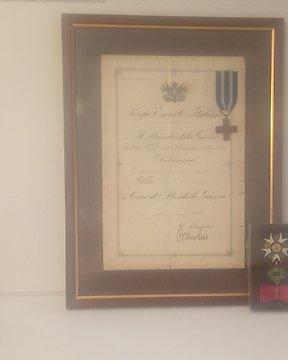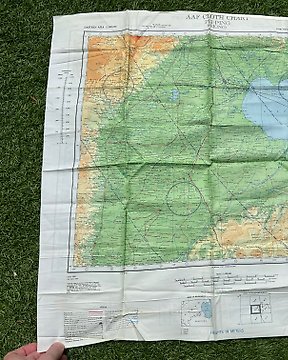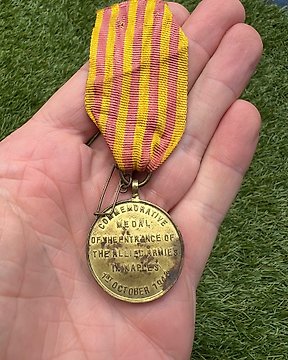Parfait; très bien emballé.
Vizualizați traducereaStatele Unite ale Americii - WW2 US Army M-1938 Lensatic Busolă + husă de transport - de lucru - Infanterie - Aeropurtată - Echipament militar - 1944
Nr. 85334751



Offered for auction is a very nice US Army WW2 M-1938 lensatic compass, as used by officers and lowers ranks during WW2. This version dates around 1944, see history below. It is complete with the rare cloth / webbing carrying pouch that is in a beautifully worn condition, certainly used! The compass works great, and the pouch studs as well. Overall a nice set for your collection. The lens works and the compas needle freely moves, and the optic is clear. It is dated '44'' on the top, i.e., 1944. This compas was made by the famous Superior Magneto compass company, Uncleaned, and totally left as found.
Great and rare 100% original item from WW2! See also our other interesting military books and militaria for sale!
History of the The M-1938 Lensatic Compass
Undoubtedly, U. S. Army service personnel became aware of the Verner prismatic compasses while serving with their British counterparts in World War I. The Army authorized research and development projects to develop a new compass at the request of the U. S. Army’s Infantry School in Fort Benning. The first of these R&D projects for a new compass was issued on March 21, 1928. The agency responsible for the research and development of compasses for the U.S. Army, at that time, was The Engineering and Topographic Laboratories at Fort Belvoir, Virginia. Additional research projects were issued until 1938. Special Project 280 (SP-280) was authorized on October 21, 1938, to find a suitable commercial lensatic compass for the Infantry that met the Infantry School’s requirements. The Engineer Board did not discover a commercial compass that met the standards published by the Infantry School. However, two companies, The W. &L. E. Gurley Company and The Taylor Instrument Company offered to make new compass prototypes based on the Infantry School’s requirements. After the testing and modifications of their compasses, they were recommended for procurement in 1940. Both manufacturers supplied compasses to the U. S. Army during World War II. Their compasses were designated as the M-1938 Lensatic Compass.
The U. S. Army continued to suggest improvements to the M-1938 lensatic compass throughout World War II. For example, there were several attempts to solve the mechanical dampening problem with the lensatic compass. In short, they were attempting to find ways to keep the compass needle from oscillating when taking a bearing. Reducing oscillation of the needle helps to gain a more accurate reading when taking an azimuth and bearing for land navigation. A liquid was commonly used for dampening in the lensatic compasses through most of World War II. The use of liquid dampening was a better option for the technology of the times. However, experimentation with the dampening process continued throughout the war.
Offered for auction is a very nice US Army WW2 M-1938 lensatic compass, as used by officers and lowers ranks during WW2. This version dates around 1944, see history below. It is complete with the rare cloth / webbing carrying pouch that is in a beautifully worn condition, certainly used! The compass works great, and the pouch studs as well. Overall a nice set for your collection. The lens works and the compas needle freely moves, and the optic is clear. It is dated '44'' on the top, i.e., 1944. This compas was made by the famous Superior Magneto compass company, Uncleaned, and totally left as found.
Great and rare 100% original item from WW2! See also our other interesting military books and militaria for sale!
History of the The M-1938 Lensatic Compass
Undoubtedly, U. S. Army service personnel became aware of the Verner prismatic compasses while serving with their British counterparts in World War I. The Army authorized research and development projects to develop a new compass at the request of the U. S. Army’s Infantry School in Fort Benning. The first of these R&D projects for a new compass was issued on March 21, 1928. The agency responsible for the research and development of compasses for the U.S. Army, at that time, was The Engineering and Topographic Laboratories at Fort Belvoir, Virginia. Additional research projects were issued until 1938. Special Project 280 (SP-280) was authorized on October 21, 1938, to find a suitable commercial lensatic compass for the Infantry that met the Infantry School’s requirements. The Engineer Board did not discover a commercial compass that met the standards published by the Infantry School. However, two companies, The W. &L. E. Gurley Company and The Taylor Instrument Company offered to make new compass prototypes based on the Infantry School’s requirements. After the testing and modifications of their compasses, they were recommended for procurement in 1940. Both manufacturers supplied compasses to the U. S. Army during World War II. Their compasses were designated as the M-1938 Lensatic Compass.
The U. S. Army continued to suggest improvements to the M-1938 lensatic compass throughout World War II. For example, there were several attempts to solve the mechanical dampening problem with the lensatic compass. In short, they were attempting to find ways to keep the compass needle from oscillating when taking a bearing. Reducing oscillation of the needle helps to gain a more accurate reading when taking an azimuth and bearing for land navigation. A liquid was commonly used for dampening in the lensatic compasses through most of World War II. The use of liquid dampening was a better option for the technology of the times. However, experimentation with the dampening process continued throughout the war.
- 640
- 14
- 2
Het object zag er keurig uit en was erg veilig verpakt. Niets meer dan lof!
Vizualizați traducerealibro perfetto, come da descrizione ed immagini, consegna puntuale in buon imballaggio, eccellente.
Vizualizați traducereaHeel mooi boekje, goed verpakt en snel verstuurd. Bedankt!
Vizualizați traducereaNetjes verzonden en alles zoals omschreven. Heel blij mee bedankt! 👍
Vizualizați traducereasome blank and cut sheets
Vizualizați traducereaExactly, as mentioned in the description: '' NOTE: in the US section some insignia photo's were cut out (see attached photo's).'', so with photo's added. How could it possible be more clear?
Heel snel geleverd. Object was ook goed verpakt. Object zelf (kompas uit WO II) was precies zoals omschreven. Prachtig stuk.
Vizualizați traducereaPerfect!!! Thanks.
Vizualizați traducereaWell packed, send quickly. Product as shown. Recommended seller.
Vizualizați traducereaServizio ottimo e rapido😉👍🏻
Vizualizați traducereaSnel en in goede orde ontvangen. Erg mooi. bedankt.
Vizualizați traducereasnel bezorgd goed ingepakt een eerlijke verkoper
Vizualizați traducereaOttimo affare, venditore consigliato!
Vizualizați traducereaBen een aantal dagen in het buitenland. Het item werd (snel) afgeleverd bij de dochter. Kreeg geen enkele negatieve commentaar.
Vizualizați traducereaGreat seller !!!
Vizualizați traducereaGreat seller !!!
Vizualizați traducereasehr guter Zustand------hat mir auch incl. Versand und Aufgeld € 105.-gekostet
Vizualizați traducereapakket geleverd als op de foto's.
Vizualizați traducereaHeel mooi aankoop dank U
Vizualizați traducereaFine book, quick and safe (!) delivery. Thank you!
Vizualizați traducereaTrès bel objet, envoi très rapide, vendeur à recommander. Merci.
Vizualizați traducereaGreat thanks a lot!
Vizualizați traducereaSnelle verzending, alles perfect!
Vizualizați traducereaTransaction parfaite. Expédition éclaire. Très positif
Vizualizați traducereaDeclinarea responsabilității
Obiectele conţinute în acest lot sunt destinate exclusiv colecţionarilor de obiecte militare-istorice. Proprietarul website-ului nu are niciun motiv politic şi/sau de altă natură decât de a oferi o platformă ce permite celei de-a treia părţi să vândă sau să cumpere loturi la licitaţie, şi nu îşi asumă nicio responsabilitatea cu privire la conţinutul acestora.
Obiectele conţinute în acest lot sunt destinate exclusiv colecţionarilor de obiecte militare-istorice. Proprietarul website-ului nu are niciun motiv politic şi/sau de altă natură decât de a oferi o platformă ce permite celei de-a treia părţi să vândă sau să cumpere loturi la licitaţie, şi nu îşi asumă nicio responsabilitatea cu privire la conţinutul acestora.









